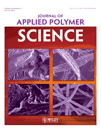Annealing effect on chain segment motion and charge detrapping in polyamide 610
Abstract
The chain segment motion and charge detrapping in polyamide 610 films have been investigated by means of thermally stimulated depolarization current (TSDC) and wide-angle X-ray diffraction. There are three current peaks (namely α, ρ1, and ρ2 peaks) in the TSDC spectra above room temperature. α peak is attributed to a dipole relaxation by the motion of chain segments ρ1 peak is caused by space charge trapped in amorphous phase and the interphase between crystalline and amorphous phases, and ρ2 peak is brought about by space charge trapped in crystalline phase. By analyzing the characteristic parameters of these peaks, it is found that annealing induces the decrease of chain segment mobility and promotes the creation of structural traps in polyamide 610. The decrease of chain segment mobility in amorphous phase makes intensity of α peak weak and activation energy increscent. The higher the annealing temperature, the higher the degree of crystallinity, the more the charge carriers trapped in crystalline phase. So, the increase of degree of crystallinity makes intensity of ρ2 peak strong and increases the stability of trapped charge in the crystalline phase. The increase of annealing temperature makes intensity of ρ1 peak strong and decreases the stability of trapped charge in the amorphous phase and interphase. © 2011 Wiley Periodicals, Inc. J Appl Polym Sci, 2011




